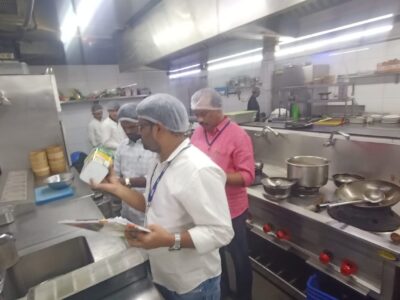I am now, officially, a lover of Bengali food, when I deftly picked the bones from the deliciously pan fried Rau Maach, and relished it till the last bite, when I didn’t think twice to bite into the sinfully oily Baigun Bhaja, when I thought that the Puchka was the best in the world, when I was almost in tears while eating the mustardy gravy Shorso Papda mixed in steamed rice, when I couldn’t just have enough of the Kosha Mangsho with Luchi, and when I didn’t mind it one bit that almost all the dishes were made in mustard oil. I was at Radisson Blu, Banjara Hills for the Bengali Food festival. One word of congratulations to the team at Radisson Blu, who made some of the most delicious Bengali fare that I ever tasted!
And so when my colleague from media Saima Afreen and the techie cum foodie Pallab De, both uprooted Bengalis, who made Hyderabad their home, started narrating tales of Calcutta food, I was all ears, and later I did my bit of research.
The tenth and last nawab of Awadh Wajid Ali Shah (1856), was stripped of all royal privileges, and the banished Nawab made Metiabruz, near Kolkata his home. He brought along with him his entourage of dancers, entertainers and khansamas and with then the cooking traditions of Lucknow that were destined to attain a new hue with some Bengali influence. He was on limited royalty that the British paid him, Rs 1 lakh per month, and it was difficult to feed his men, but the Nawab, a man of honour wouldn’t settle for anything less. So the cooks when they had to make biriyani for 100s of men and the meat would be less, used potatoes to add volume and the recipe stayed on. Today, it is unimaginable for Bengali Biriyani, or any meat dish for that matter without potato. Over a period of time use of dalda was replaced with mustard oil. Apparently it was these khansamas that adapted fish into kebabs – imagine all the work that’s involved considering the fish has to be cleaned, deboned…
Manzilat Khan, also known as Manzie, great great grand daughter of Wajid Ali Shah draws her lineage from Nawab’s principal Begum Hazrat Mahal. She has a leather business, and is known for her biriyanis.

Pic Courtesy: rolandhotel.com
The story of the famous Kathi Roll is traced back to one hotel, ‘Nizam’s’ at Hogg’s street (New Market). When an English man came in demanding for food, the cook at Nizam restaurant made the first Kathi roll ever made in the early 30s by rolling skewered meat into a paratha. Today, it is the queen of street food in Kolkata.
More tales for later, when I come across good Bengali food once again.
















Yum, yum!
True! Did you ever get to taste Bengali food?
Yup, quite a few Bengali restaurants are there in Bangalore. Moreover, I have many Bengali friends too. 😁
Looks yummy!
It was indeed delicious
Being a bengali I can say food is an integral part of our life.our whole culture revolves around food,with different festival ,season ,occasion are menu changes.and yeah adding potato and an egg to any chicken or mutton biryani is like a full package.
I love it the way it is…potatoes and all